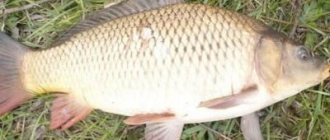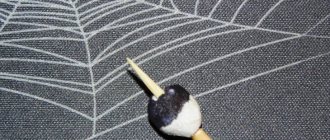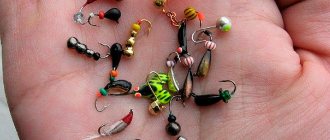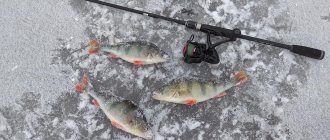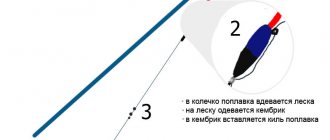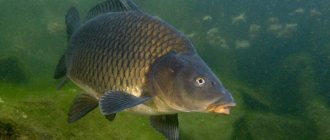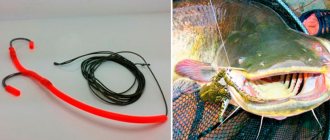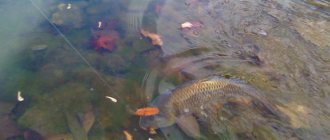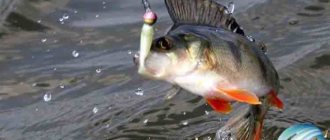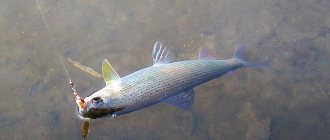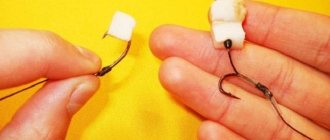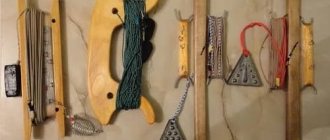Catching catfish is a complex process that requires special preparation. For these purposes, you can use a quok, donka or feeder, and also try to make suitable tackle yourself.
Features of gear for catfish
Donka from the shore
For catching catfish from the shore, the simplest donkey is suitable; such tackle is easy to assemble, so it is recommended for novice fishermen.
There are two options suitable for catfish:
- Bottom tackle with a strong rod from an alloy spinning rod or fishing rods designed for sea fishing. The rod and reel must be strong and durable to withstand resistance from strong fish. Typically, monofilament with a diameter of 0.5 to 1 mm is used with such tackle, depending on the expected size of the prey, but if you want to catch a trophy catfish, you should use only braided cords with a thickness of up to 0.8 mm. The rig contains stationary or sliding sinkers; when fishing for catfish in areas without a rapid current, their weight should be about 100-150 grams. Particular attention is paid to hooks - they must have increased strength.
- A bottom casting tackle without a rod is used when catching catfish in areas of a reservoir with a fast current. In this case, the fishing line is attached to any reliable objects located on the shore; It is best to use a nylon cord for these purposes. A sinker and leashes, the diameter of which is 0.5-0.8 mm, are attached to it. The weight of the sinker is determined individually, taking into account fishing conditions; the hook can be single, sometimes doubles or trebles are used - the choice depends on the expected size of the prey.
Sheer fishing with kwok
Another device that can be used for catching catfish is a quok, consisting of a handle, a hoof and a cutwater.
Some fishermen make their own kwoka; fishing stores also offer a wide range of models that differ in shape, size, material and other features.
A high-quality quok must meet the following requirements:
- The handle should be light and comfortable; it is recommended to give preference to wooden options.
- The water cutter should be thin and made of metal, which will allow it to enter the pond without creating a large amount of splashes.
- The material of the claw is not critical; it can be made of wood, plastic or epoxy resin; the main requirement is a smooth surface without depressions in the middle.
- The angle between the cutwater and the handle of the quok should be 60°.
The kwok is used to strike the water, which creates a specific sound that attracts large catfish to the bait.
Fishing on a feeder
The feeder is less often used for catching catfish, but it is also capable of demonstrating good results. This gear is relevant when river fishing; you will need to choose a high-quality and durable model that can cope with high loads.
The main criteria for selecting a feeder and its equipment are given below:
- The rod must be made of high-quality carbon fiber, the test value is up to 150 g.
- The feeder must be equipped with a spinning-type coil with a volume of 4000-5000.
- The friction brake of the reel is subject to careful adjustment; without this, it will not be possible to suppress the resistance provided by the catfish.
- A braided cord 0.2 mm thick is used as a working line; For leashes, fluorocarbon fishing line with a thickness of 0.4 mm is used, their length can be 0.5-1 meter.
- It is recommended to add an anti-twist tube to the equipment.
- Hook sizes can range from No. 9 to No. 14.
Choosing gear depending on the type of fishing
Being the largest inhabitant of freshwater bodies, catfish can offer strong resistance when fishing. To get it out of the water onto the shore, you need to use strong tackle.
It must withstand not only the large weight of the predator, but also suppress its jerks. The choice of fishing tool depends on the type of fishing.
Gear requirements
When going to the store to buy tackle for catfish, you should choose reliable designs that are ready to cope with any load. There are also a number of requirements that need to be taken into account:
- Rod. It uses powerful fishing rods, adapted for a long fight with a large predator. The best option is a fiberglass model, about 3 m long (if you use longer models, this will complicate the process of controlling the jerks of the fish in the last minutes of fishing). The test load should be 100-300 g for live baits and 100-150 g for artificial products.
- Coil. For catfish fishing, use a reel with a 200 m spool made of durable materials. Experts recommend buying inertia-free models for sea fishing or multipliers. Metal carp reels are suitable for the average catfish.
- Hooks. You can catch catfish with both homemade and factory hooks. The main thing is that they are made of high quality steel. The type of hooks is determined by the size and weight of the bait. So for a large bait, use a large product numbered 8-10, and for meat shells, worms and light baits take a smaller hook (No. 5-6).
- Network. Catfish fishing is carried out using a braided cord with a thickness of 0.35−0.7 mm. Unlike classic fishing line, braided line can withstand loads of up to 30-60 kg. When catching small catfish, the use of fishing line is allowed. Its diameter should be at least 0.6−0.7 mm.
- Leash. It is advisable to use Kevlar models, which have increased flexibility and resistance to strong jerks. The breaking load indicator reaches 50−150 kg. Products made from this material bind well, are not afraid of stretching and are protected from being bitten. A good alternative for a Kevlar leash is a thick fishing line, at least 1 mm thick.
From the shore
You can catch catfish from the shore using either spinning or bottom gear. The second option is considered the most convenient, but does not belong to the category of sports. It involves installing a stationary structure on the shore and waiting for a bite.
When preparing equipment, it is necessary to take into account the specifics and location of fishing. If fishing is carried out in places with an abundance of snags, stumps and other bottom debris, it is better to use a strong fishing line with a reserve.
Single models with a long shank are used as a hook, since they are less likely to get caught on snags. The diameter of the fishing line for donkey is at least 0.6 mm. The optimal weight of the sinker is 200-300 g, and the shape is oval with a longitudinal hole.
The bottom tackle is equipped with a leash 1-1.5 mm long. A good bait for catfish is a live frog. The predator is also interested in the smell of spoiled tripe.
In open water, barbel is caught from early spring until late autumn. Sometimes winter fishing for catfish is allowed, provided that the reservoirs are not covered with ice. But it is difficult to predict how the catfish will behave in winter if its activity decreases greatly during the cold season.
From the boat
The principle of boat fishing is practically no different from shore fishing. At the same time, the presence of a swimming device allows you to change the casting location in the event of a lack of bite.
To attract a trophy, you can use a clever device - “kwok” - catching catfish using this device always brings a good catch. It creates a specific sound that attracts fish from a great distance. The bait used is live bait, frog or crawler.
Making your own tackle
Tackle purchased in stores is not always able to withstand the high loads that occur when catching catfish, so many fishermen prefer to make and equip them themselves.
The basic rules associated with this process are outlined below:
- Initially, it is important to choose a suitable fishing rod: only short sticks are suitable for fishing from a boat; when fishing from the shoreline, the length of the tackle is determined by the estimated size of the catfish. Rods up to 2 meters long are only suitable for cases where the weight of the prey does not exceed 10 kg. It must be remembered that to catch large catfish you will need appropriate bait, so it is important to choose a rod with the appropriate test. Other requirements for this part of the tackle are strength and elasticity.
- Reel: Inertia-free models are most often used, but when catching trophy catfish, it is recommended to install a multiplier on the tackle, as it will reduce the risk of the prey disappearing during the process of fishing it.
- A reel will be required if you plan to catch catfish using a donkey without a rod. Regardless of the fishing conditions, the position of the reel must be securely fixed so that the fish does not drag it along with the equipment into the pond.
- The diameter of the monofilament is usually 0.7-0.9 mm, it is selected depending on other features of the gear, the main requirement will be maximum strength.
- The choice of sinkers depends on the conditions and fishing style. When fishing on rivers with rapid currents, take massive lead sinkers that will not be carried away by currents of water. The same option should be used when fishing with large live bait that can move the bait from the casting point. When casting, preference is given to streamlined weights with medium weight, but when fishing vertically, heavier and more compact options are better suited.
- Single hooks are used when catching catfish with small baits, but most often doubles and treble hooks are required; the only requirements for them are high strength and good sharpness.
Spinning tackle
Spinning fishing is considered a difficult activity that involves fighting large prey. To remove a river monster from the water, you need to use powerful, functional and reliable fishing rods with good shock-absorbing properties.
When collecting gear for trolling catfish, you should give preference to special models designed for this method of fishing.
Selection of wobblers
One of the most effective baits for catching catfish is a wobbler. Fish are well attracted to both floating and sinking models, and the key requirement is the depth of the product. This property is provided by the manufacturer, but the angler can change the immersion depth of the wobbler himself.
When catching catfish by trolling, you need to consider the following factors:
- Diameter of braided line.
- Distance between boat and bait.
- The speed of the boat.
The bait will be submerged to the maximum depth when using a thin line. Fans of trolling fishing prefer the following models of wobblers: Rapala Super Shad Rap, Mann's Stretch, Halco Sorcerer and Bomber Deep Down Long A.
The listed wobblers for catfish demonstrate good effectiveness due to the wide variety of colors, stable and attractive play, as well as good immersion depth. And according to experienced spinning anglers, a “bomber” wobbler for catfish is the best solution in its price category, allowing you to attract even lazy fish.
Spoons
Every angler's arsenal should include catchable lures for catfish. Particular attention is paid to thick-walled models with large dimensions and heavy weight.
The bait is slowly pulled along the bottom, causing the turbidity to rise, which creates an imitation of the movements of live prey.
Coil selection
If you are interested in how to catch catfish, you need to carefully select a reel. It uses a reinforced product with a spool capacity of up to 3000-5000. At the same time, the predator is caught with both powerful carp reels and models for sea fishing.
For catching catfish by trolling, both power multipliers and inertia-free structures are allowed.
Rod
An important element of equipment for catfish is the fishing rod. It should be as durable as possible, able to withstand strong and aggressive jerks. The optimal length is 2.7−3 m, and the test is 20−60 g. Preference is given to forms with a fast action.
Hooks
To catch catfish with live bait or artificial bait, you must use high-quality hooks. They must be made of durable materials, have sufficient size and degree of sharpening. You can use both store-bought and homemade hooks for catfish (The size of the hooks is determined by the size of the expected catch).
If you expect to catch 5-kilogram specimens, you can get by with carp hooks. Larger predators are caught with hooks numbered 5,9, 10 and larger, depending on their weight. You can't skimp on these products.
Installation
At the stage of installation of gear for catching catfish with spoons or live bait, the reel is equipped with a strong fishing cord or fishing line, 200 m long. A load is fixed at the end of the main line, and a leash and hooks are attached at a distance of 50 cm from the load.
Swivels or carabiners are used as fastening elements. Fishermen also advise installing a leash with a forged hook, instead of a single product.
How and where to catch catfish?
The most promising places for catching catfish are large rivers with warm water; this fish tries to avoid small cold reservoirs. The fisherman will need to find a quiet place with deep-water holes, preferably filled with snags or covered with underwater vegetation.
It is best to go fishing in the evening or at night, since at this time catfish often hunt in shallow reaches.
To begin with, you can try to fish the shallows in the bay in areas with a depth of at least a meter, where catfish often hunt frogs. This rule is only relevant for fishing in clear and warm weather; during stormy and cool days, when there is a large amount of precipitation, the catfish tries not to get close to the shore and stays at great depths, so you will need to use gear capable of long casts and appropriate baits .
The most difficult stage is fishing for prey, since the catfish has impressive strength and offers active resistance. For this reason, you should not rush and try to immediately pull the fish ashore; first you need to wait until the moment when it gets tired and stops resisting.
When going underwater and trying to hide at the bottom, you need to strike the rod lightly: they will create vibration and scare the prey, forcing it to rise to the surface of the reservoir.
Good to know! When a fish floats up belly up, you can try to bring it to shallow water, where it is taken under the gills and pulled ashore. All actions must be carried out wearing protective gloves on your hands to avoid painful cuts from the fishing line.
Lures for catching catfish
When catching catfish, the following types of bait usually show good results:
- In fact, any type of bait of animal origin: locusts, mole crickets, earthworms, dung worms, leeches - all of them are attached to several hooks at a time.
- When fishing with live bait, the most commonly used are pike or asp fry, ide, and sabrefish.
- Pieces of fish fillet: you can use not only fresh, but also rotten meat.
- Poultry giblets, to increase the effectiveness of this bait, are preliminarily smoked over a fire.
- Live frogs.
- Crayfish meat.
Good to know! When catching catfish with spinning tackle, artificial baits are used; twisters are the most effective;
vibrating tails equipped with heavy weight heads and wobblers designed for deep-sea fishing.
Reviews and advice from fishermen on catching catfish
Below are tips and tricks left by experienced anglers for people going catfishing for the first time:
- It is important to learn to determine the right moment to hook the prey: this should be done only after a strong jerk, ignoring minor tugging.
- To attract the attention of prey, you can use store-bought fishing scents, but they quickly lose their basic properties in the water, so it is recommended to moisten small pieces of foam rubber with them, which are then placed on hooks instead of baits.
- You should always try to lead a caught catfish to a shallow section of a reservoir, where the activity of its resistance decreases.
- Often fishing is done with live bait: it must be taken directly from the body of water where the catfish lives.
- Dead fish are the best bait option for channel catfish. It is recommended to dry it first on a mosquito net so that the fish does not get wet longer and does not fall apart in the water.
How to make a donka for catfish with your own hands?
To make a donk on your own, you will need a strong fishing line with a diameter of 0.5-1 mm, hooks number 10-40, plus a heavy weight.
Step-by-step creation instructions look like this:
- At the very beginning, a sinker is attached to the fishing line, and already above it, at a distance of 30-40 cm, leashes are attached and, using a carabiner, this is attached to the main part with a carabiner.
- Next, take any homemade equipment - it can be made from any strong, available material. And here it is good because it allows you to hunt for catfish of any size.
- You need a fishing line - take a twine, twisted or braided, that can withstand a load of up to 30-35 kilograms, and here it is important not to skimp on its length, reeling out 100-150 meters.
- The weight can be bought either in a store or cast from lead in the shape you need - it is attached at a distance of 40-80 cm from the hook.
Good to know! Everything is quite simple and easy - if you have time and desire, you can assemble it yourself.
